HI3042 Taxation Law T2 2017 Individual Assignment: Tax Implications
VerifiedAdded on 2020/04/07
|11
|1489
|259
Homework Assignment
AI Summary
This document presents a comprehensive solution to a taxation law assignment, addressing several key issues. The first question analyzes general expense deductions under s. 8(1) ITAA 1997, differentiating between capital and revenue expenses across various scenarios. The second question focuses on input tax credits for advertising expenses, determining the creditable amount based on taxable supplies and the Financial Acquisition Threshold. The third question examines the extent of foreign tax offsets available, considering double taxation avoidance agreements. Finally, the fourth question calculates the taxable income of a partnership firm, outlining the steps involved in determining total income and deductions. The solution references relevant legal principles and case laws to support its conclusions.
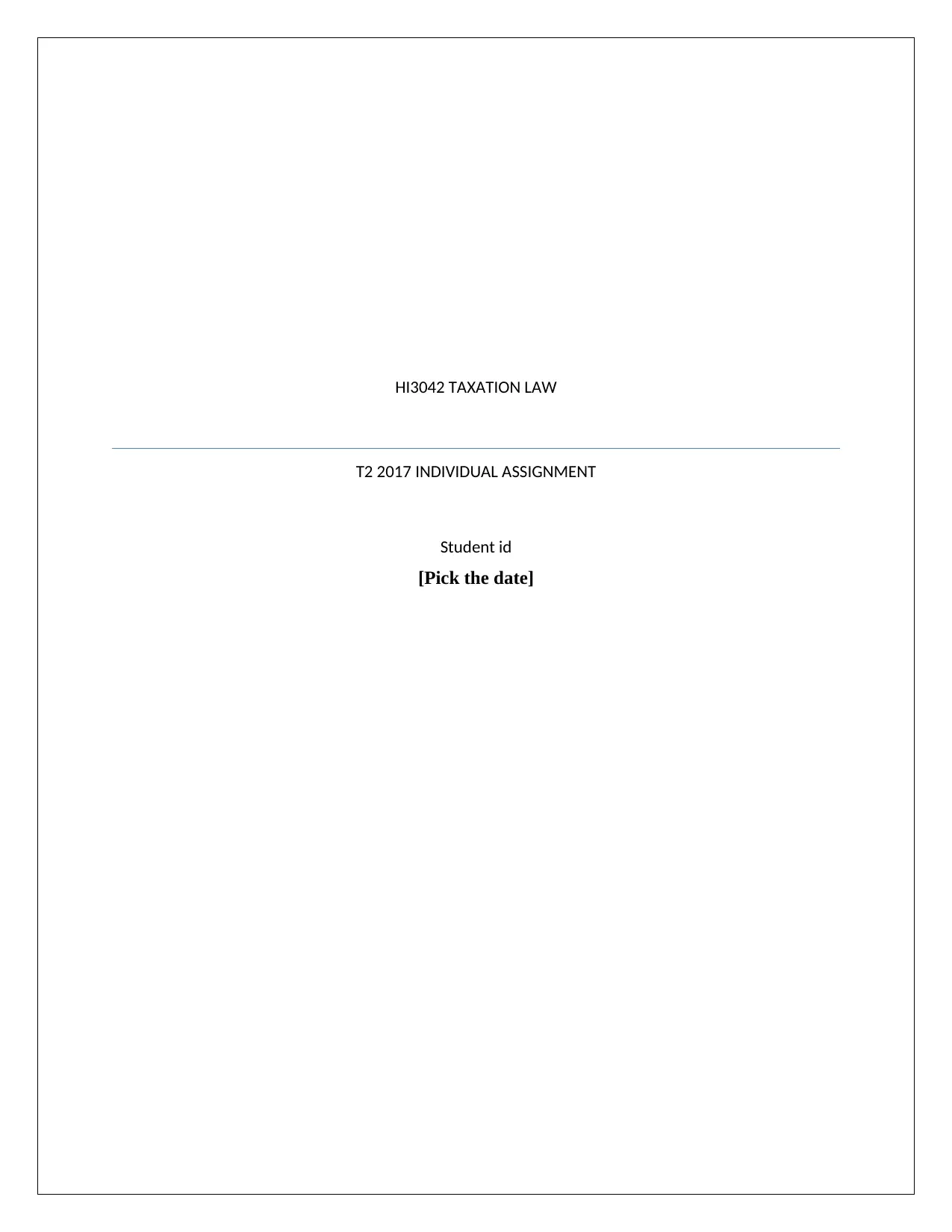
HI3042 TAXATION LAW
T2 2017 INDIVIDUAL ASSIGNMENT
Student id
[Pick the date]
T2 2017 INDIVIDUAL ASSIGNMENT
Student id
[Pick the date]
Paraphrase This Document
Need a fresh take? Get an instant paraphrase of this document with our AI Paraphraser
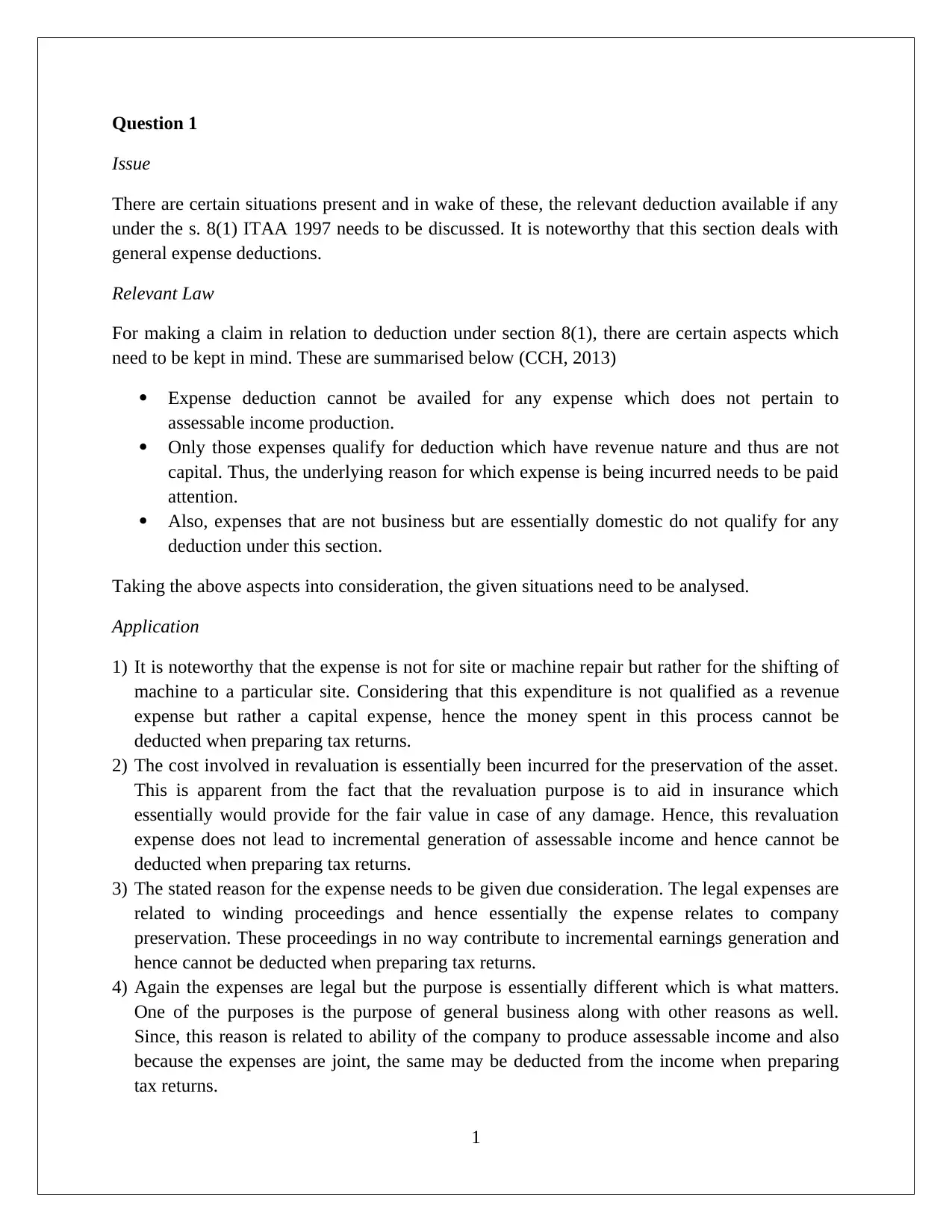
Question 1
Issue
There are certain situations present and in wake of these, the relevant deduction available if any
under the s. 8(1) ITAA 1997 needs to be discussed. It is noteworthy that this section deals with
general expense deductions.
Relevant Law
For making a claim in relation to deduction under section 8(1), there are certain aspects which
need to be kept in mind. These are summarised below (CCH, 2013)
Expense deduction cannot be availed for any expense which does not pertain to
assessable income production.
Only those expenses qualify for deduction which have revenue nature and thus are not
capital. Thus, the underlying reason for which expense is being incurred needs to be paid
attention.
Also, expenses that are not business but are essentially domestic do not qualify for any
deduction under this section.
Taking the above aspects into consideration, the given situations need to be analysed.
Application
1) It is noteworthy that the expense is not for site or machine repair but rather for the shifting of
machine to a particular site. Considering that this expenditure is not qualified as a revenue
expense but rather a capital expense, hence the money spent in this process cannot be
deducted when preparing tax returns.
2) The cost involved in revaluation is essentially been incurred for the preservation of the asset.
This is apparent from the fact that the revaluation purpose is to aid in insurance which
essentially would provide for the fair value in case of any damage. Hence, this revaluation
expense does not lead to incremental generation of assessable income and hence cannot be
deducted when preparing tax returns.
3) The stated reason for the expense needs to be given due consideration. The legal expenses are
related to winding proceedings and hence essentially the expense relates to company
preservation. These proceedings in no way contribute to incremental earnings generation and
hence cannot be deducted when preparing tax returns.
4) Again the expenses are legal but the purpose is essentially different which is what matters.
One of the purposes is the purpose of general business along with other reasons as well.
Since, this reason is related to ability of the company to produce assessable income and also
because the expenses are joint, the same may be deducted from the income when preparing
tax returns.
1
Issue
There are certain situations present and in wake of these, the relevant deduction available if any
under the s. 8(1) ITAA 1997 needs to be discussed. It is noteworthy that this section deals with
general expense deductions.
Relevant Law
For making a claim in relation to deduction under section 8(1), there are certain aspects which
need to be kept in mind. These are summarised below (CCH, 2013)
Expense deduction cannot be availed for any expense which does not pertain to
assessable income production.
Only those expenses qualify for deduction which have revenue nature and thus are not
capital. Thus, the underlying reason for which expense is being incurred needs to be paid
attention.
Also, expenses that are not business but are essentially domestic do not qualify for any
deduction under this section.
Taking the above aspects into consideration, the given situations need to be analysed.
Application
1) It is noteworthy that the expense is not for site or machine repair but rather for the shifting of
machine to a particular site. Considering that this expenditure is not qualified as a revenue
expense but rather a capital expense, hence the money spent in this process cannot be
deducted when preparing tax returns.
2) The cost involved in revaluation is essentially been incurred for the preservation of the asset.
This is apparent from the fact that the revaluation purpose is to aid in insurance which
essentially would provide for the fair value in case of any damage. Hence, this revaluation
expense does not lead to incremental generation of assessable income and hence cannot be
deducted when preparing tax returns.
3) The stated reason for the expense needs to be given due consideration. The legal expenses are
related to winding proceedings and hence essentially the expense relates to company
preservation. These proceedings in no way contribute to incremental earnings generation and
hence cannot be deducted when preparing tax returns.
4) Again the expenses are legal but the purpose is essentially different which is what matters.
One of the purposes is the purpose of general business along with other reasons as well.
Since, this reason is related to ability of the company to produce assessable income and also
because the expenses are joint, the same may be deducted from the income when preparing
tax returns.
1

Conclusion
The above reasoning clear indicate that deduction was not available for capital expenses and only
in the last case was the revenue expense apparent and hence deduction was extended in
accordance with s.8(1).
Question 2
Issue
For the advertising spending that Big Bank has done, the objective is to determine the exact
quantum of input tax credits that they can claim on account of this.
Relevant Law
The critical aspects in relation to the input tax credit claim are mentioned below (Barkoczy,
2017).
It is not that all acquisitions are necessarily creditable and only those acquisitions which
can be termed as taxable supplies give rise to input credits.
The threshold value defined as FAT must not be breached or else full claim of the credits
generated would not be possible.
The FAT definition comes from GST Act whereby it is essentially termed as the value which is
lower from two values out of which one is $ 150,000 and the other is the equivalent amount to
10% of the cumulative input tax credits that the given entity is entitled to (Gilders et. al., 2016).
The violation of the threshold present in the form of Financial Acquisition Threshold would
adversely impact the ability of the company to claim the tax credits on the GST paid (Sadiq et.
al., 2016)
Application
Out of the total advertisement spend that the bank has gone ahead with, $ 550,000 is devoted to
the promotion of the insurance business while the remaining amount is for general advertisement
purposes. The amount spent on insurance promotion would be served as creditable acquisition
and hence input tax credit may be availed in lieu of the GST paid.
GST paid for the advertisement spending related to promotion of insurance business = $550,000
* (1/11) = $ 50,000
In relation to the general advertising, it is imperative to distribute and link a portion of the
expense to the insurance business. As per the information given in the question, currently for the
2
The above reasoning clear indicate that deduction was not available for capital expenses and only
in the last case was the revenue expense apparent and hence deduction was extended in
accordance with s.8(1).
Question 2
Issue
For the advertising spending that Big Bank has done, the objective is to determine the exact
quantum of input tax credits that they can claim on account of this.
Relevant Law
The critical aspects in relation to the input tax credit claim are mentioned below (Barkoczy,
2017).
It is not that all acquisitions are necessarily creditable and only those acquisitions which
can be termed as taxable supplies give rise to input credits.
The threshold value defined as FAT must not be breached or else full claim of the credits
generated would not be possible.
The FAT definition comes from GST Act whereby it is essentially termed as the value which is
lower from two values out of which one is $ 150,000 and the other is the equivalent amount to
10% of the cumulative input tax credits that the given entity is entitled to (Gilders et. al., 2016).
The violation of the threshold present in the form of Financial Acquisition Threshold would
adversely impact the ability of the company to claim the tax credits on the GST paid (Sadiq et.
al., 2016)
Application
Out of the total advertisement spend that the bank has gone ahead with, $ 550,000 is devoted to
the promotion of the insurance business while the remaining amount is for general advertisement
purposes. The amount spent on insurance promotion would be served as creditable acquisition
and hence input tax credit may be availed in lieu of the GST paid.
GST paid for the advertisement spending related to promotion of insurance business = $550,000
* (1/11) = $ 50,000
In relation to the general advertising, it is imperative to distribute and link a portion of the
expense to the insurance business. As per the information given in the question, currently for the
2
⊘ This is a preview!⊘
Do you want full access?
Subscribe today to unlock all pages.

Trusted by 1+ million students worldwide

bank 2% of the business comes from the insurance business and hence it makes sense to assume
that 2% of the expense on general advertising would be taxable supplies.
General advertising amount linked to insurance business = (2/100)*$ 1,100,000 = $ 22,000
Input credit earned on the above = (1/11)* $22,000 = $ 2,000
Conclusion
The above computation apparently reflects that the input tax credit would not be available on the
complete advertising amount but only on taxable supplies based on which it amounts to $
52,000.
Question 3
In wake of the foreign tax aid by Angelo, the aim is to ascertain the extent of foreign tax offset
that can be availed by Angelo.
A critical aspect of the Australian tax system is that it provides provisions to ensure that a
particular income is not taxed twice. In this regards, the double taxation avoidance agreement
that Australia has enacted with other leading nations is critical. Hence, if a taxpayer has paid any
tax to any foreign tax agency, then offset to the extent of the available limit can be availed in
Australia while filing returns (Deutsch et. al, 2016). However, two critical conditions need
fulfilment i.e. the foreign income must be deemed taxable in Australia and also the tax to foreign
agencies should already have been paid (Woellner, 2014).
To determine the exact amount of offset, the limit in this regards needs to be computed for
Angelo as illustrated below (Nethercott, Richardson and Devos, 2016).
3
that 2% of the expense on general advertising would be taxable supplies.
General advertising amount linked to insurance business = (2/100)*$ 1,100,000 = $ 22,000
Input credit earned on the above = (1/11)* $22,000 = $ 2,000
Conclusion
The above computation apparently reflects that the input tax credit would not be available on the
complete advertising amount but only on taxable supplies based on which it amounts to $
52,000.
Question 3
In wake of the foreign tax aid by Angelo, the aim is to ascertain the extent of foreign tax offset
that can be availed by Angelo.
A critical aspect of the Australian tax system is that it provides provisions to ensure that a
particular income is not taxed twice. In this regards, the double taxation avoidance agreement
that Australia has enacted with other leading nations is critical. Hence, if a taxpayer has paid any
tax to any foreign tax agency, then offset to the extent of the available limit can be availed in
Australia while filing returns (Deutsch et. al, 2016). However, two critical conditions need
fulfilment i.e. the foreign income must be deemed taxable in Australia and also the tax to foreign
agencies should already have been paid (Woellner, 2014).
To determine the exact amount of offset, the limit in this regards needs to be computed for
Angelo as illustrated below (Nethercott, Richardson and Devos, 2016).
3
Paraphrase This Document
Need a fresh take? Get an instant paraphrase of this document with our AI Paraphraser
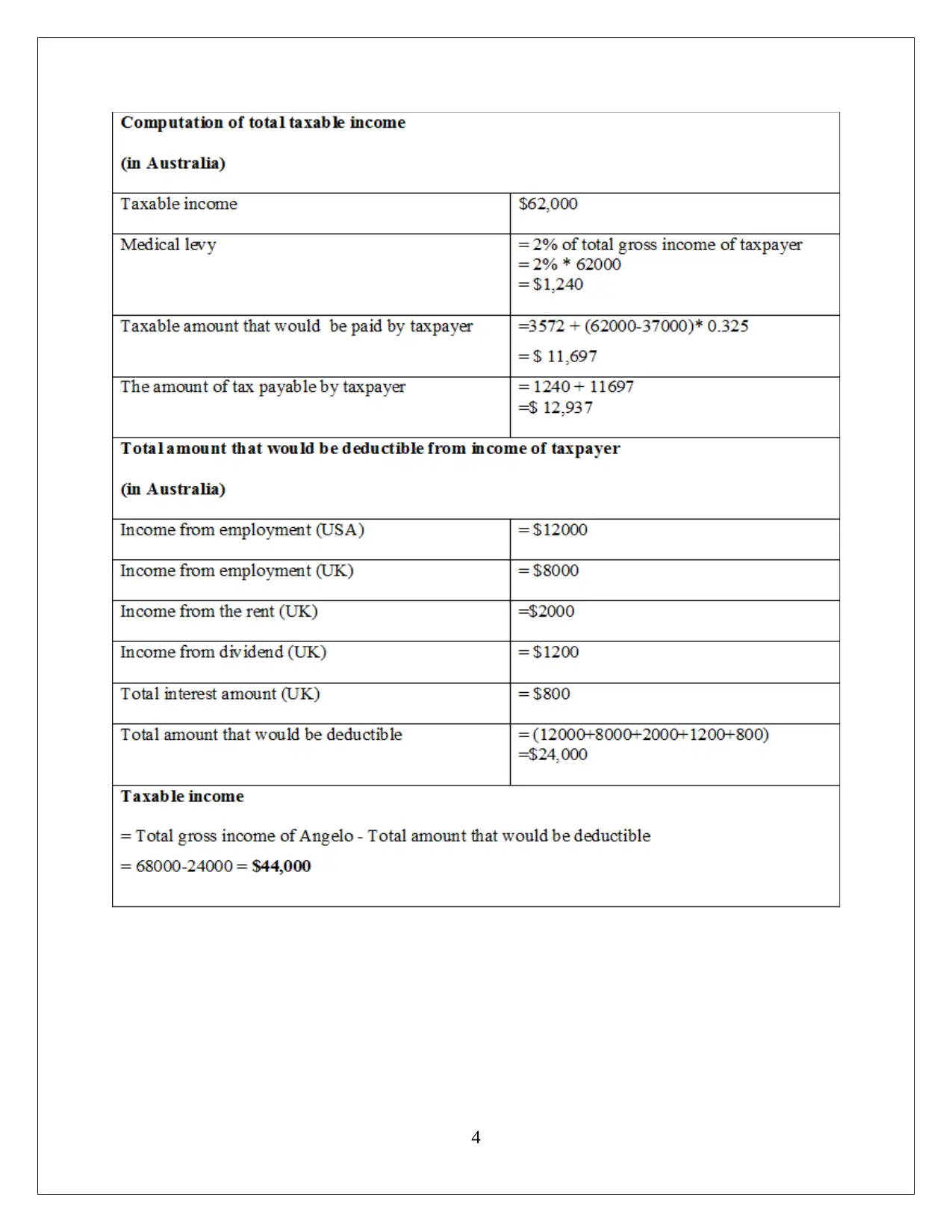
4
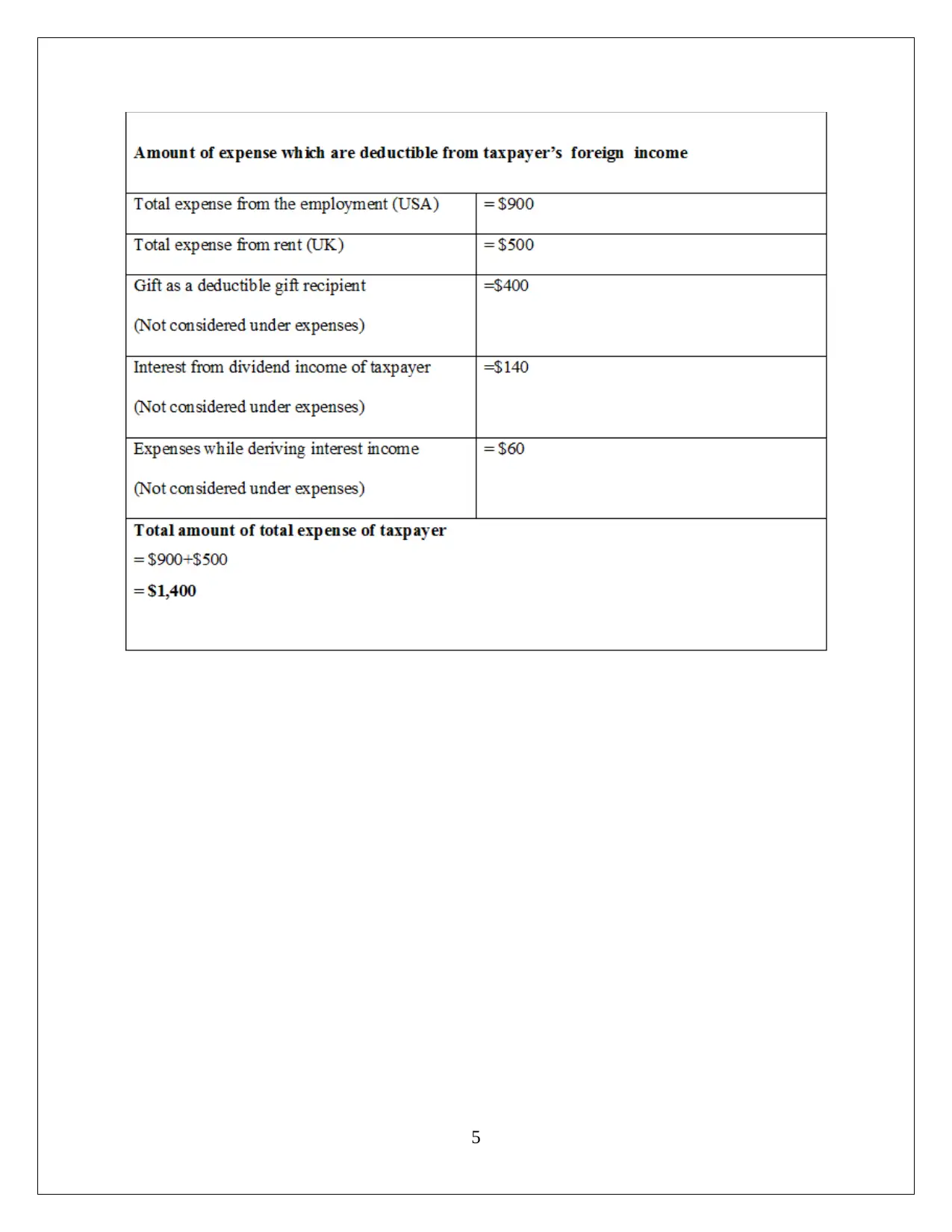
5
⊘ This is a preview!⊘
Do you want full access?
Subscribe today to unlock all pages.

Trusted by 1+ million students worldwide
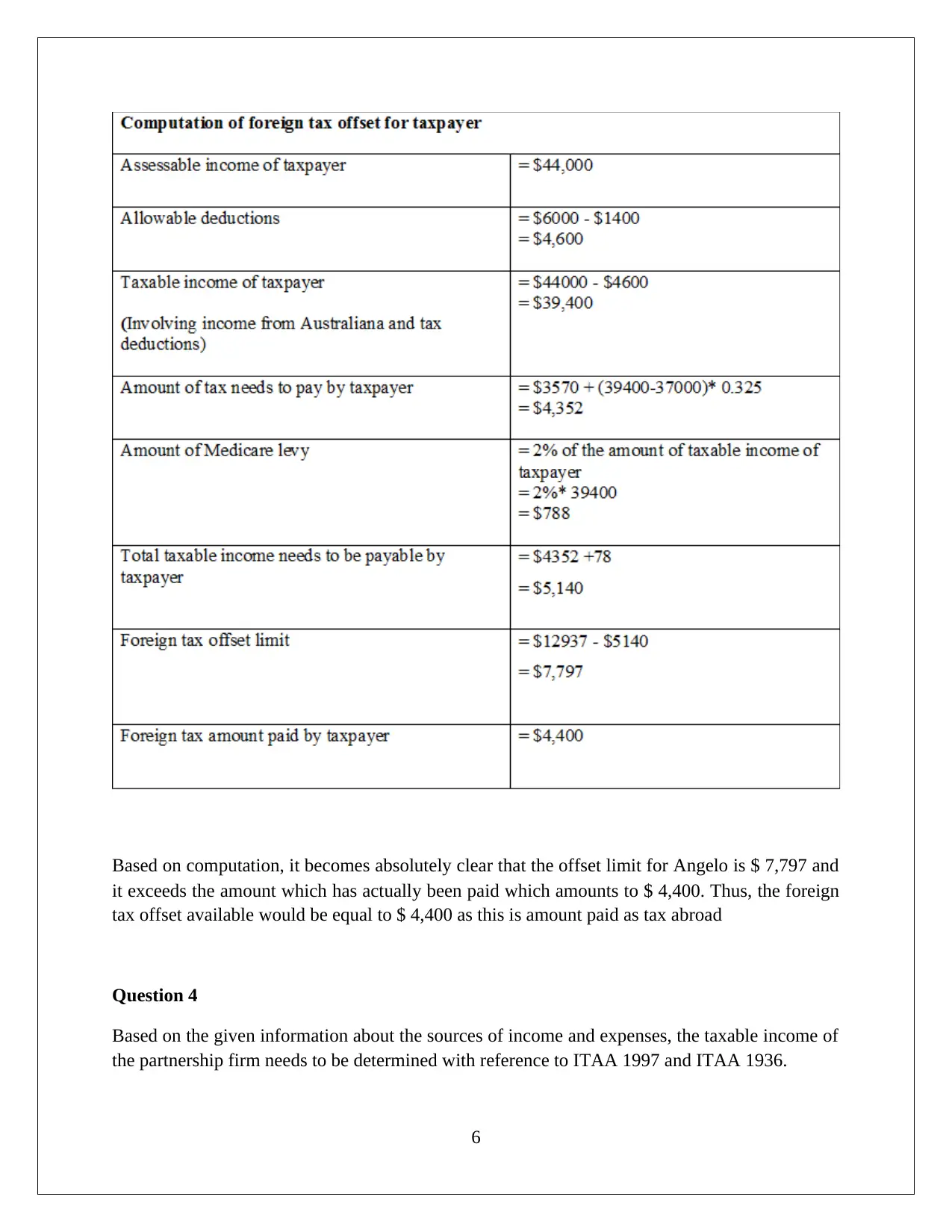
Based on computation, it becomes absolutely clear that the offset limit for Angelo is $ 7,797 and
it exceeds the amount which has actually been paid which amounts to $ 4,400. Thus, the foreign
tax offset available would be equal to $ 4,400 as this is amount paid as tax abroad
Question 4
Based on the given information about the sources of income and expenses, the taxable income of
the partnership firm needs to be determined with reference to ITAA 1997 and ITAA 1936.
6
it exceeds the amount which has actually been paid which amounts to $ 4,400. Thus, the foreign
tax offset available would be equal to $ 4,400 as this is amount paid as tax abroad
Question 4
Based on the given information about the sources of income and expenses, the taxable income of
the partnership firm needs to be determined with reference to ITAA 1997 and ITAA 1936.
6
Paraphrase This Document
Need a fresh take? Get an instant paraphrase of this document with our AI Paraphraser
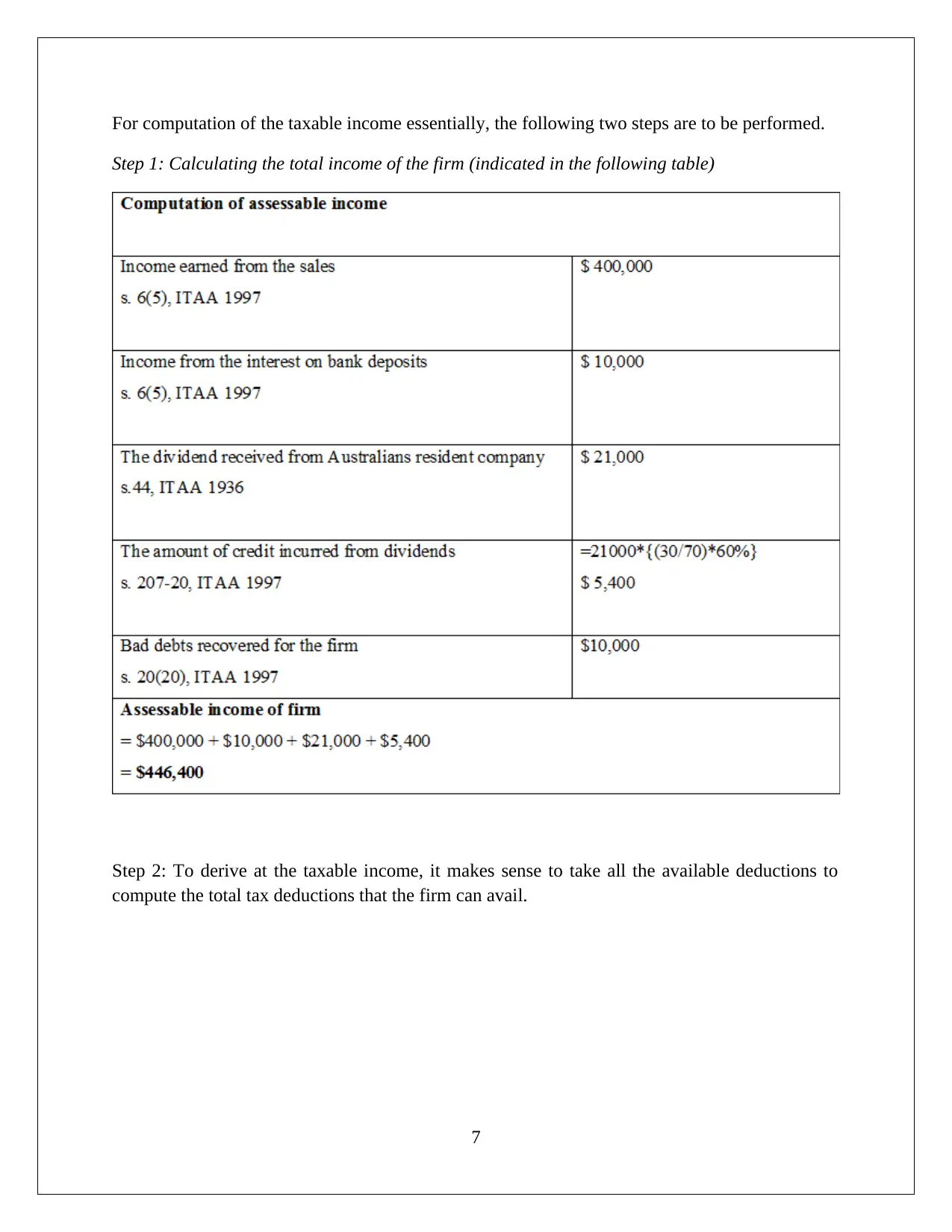
For computation of the taxable income essentially, the following two steps are to be performed.
Step 1: Calculating the total income of the firm (indicated in the following table)
Step 2: To derive at the taxable income, it makes sense to take all the available deductions to
compute the total tax deductions that the firm can avail.
7
Step 1: Calculating the total income of the firm (indicated in the following table)
Step 2: To derive at the taxable income, it makes sense to take all the available deductions to
compute the total tax deductions that the firm can avail.
7
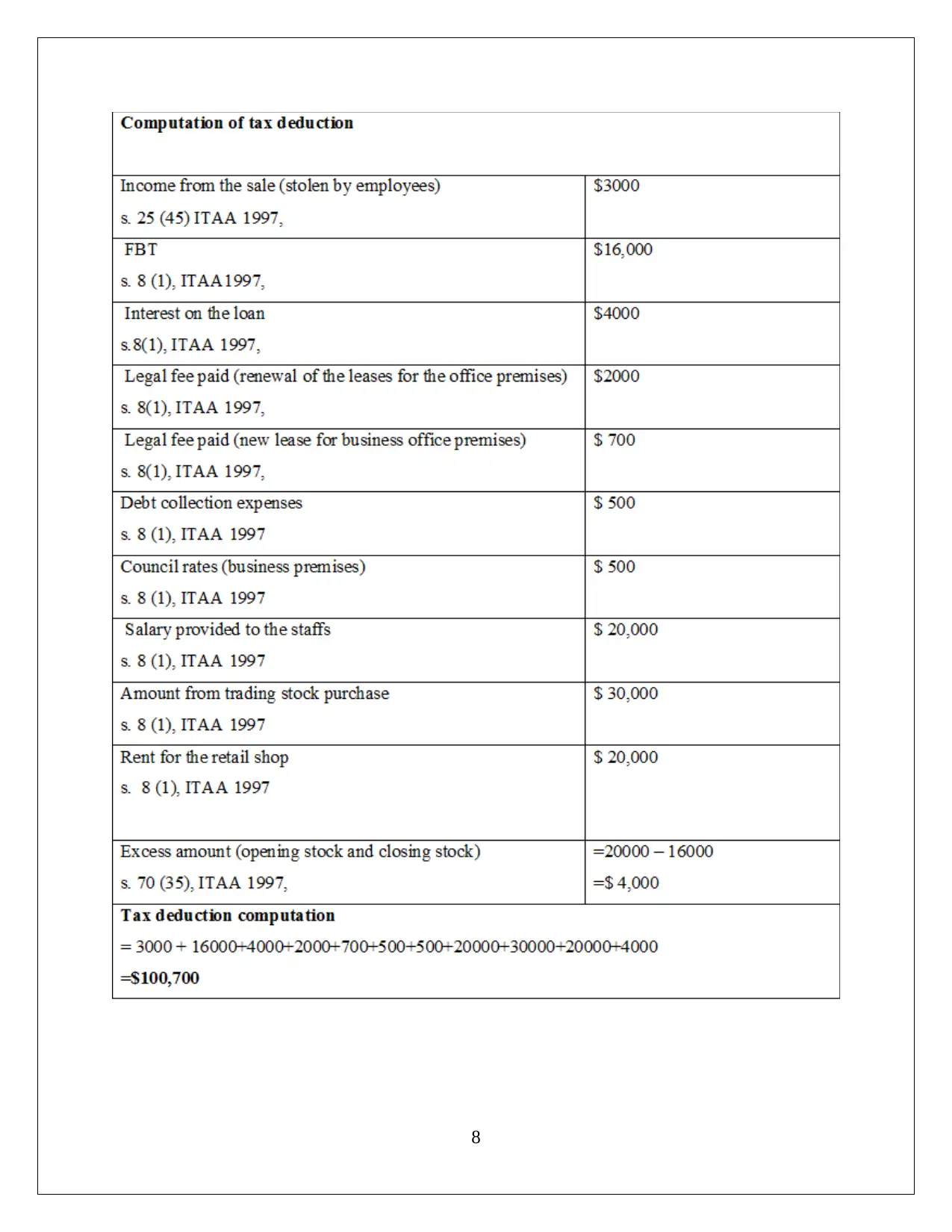
8
⊘ This is a preview!⊘
Do you want full access?
Subscribe today to unlock all pages.

Trusted by 1+ million students worldwide
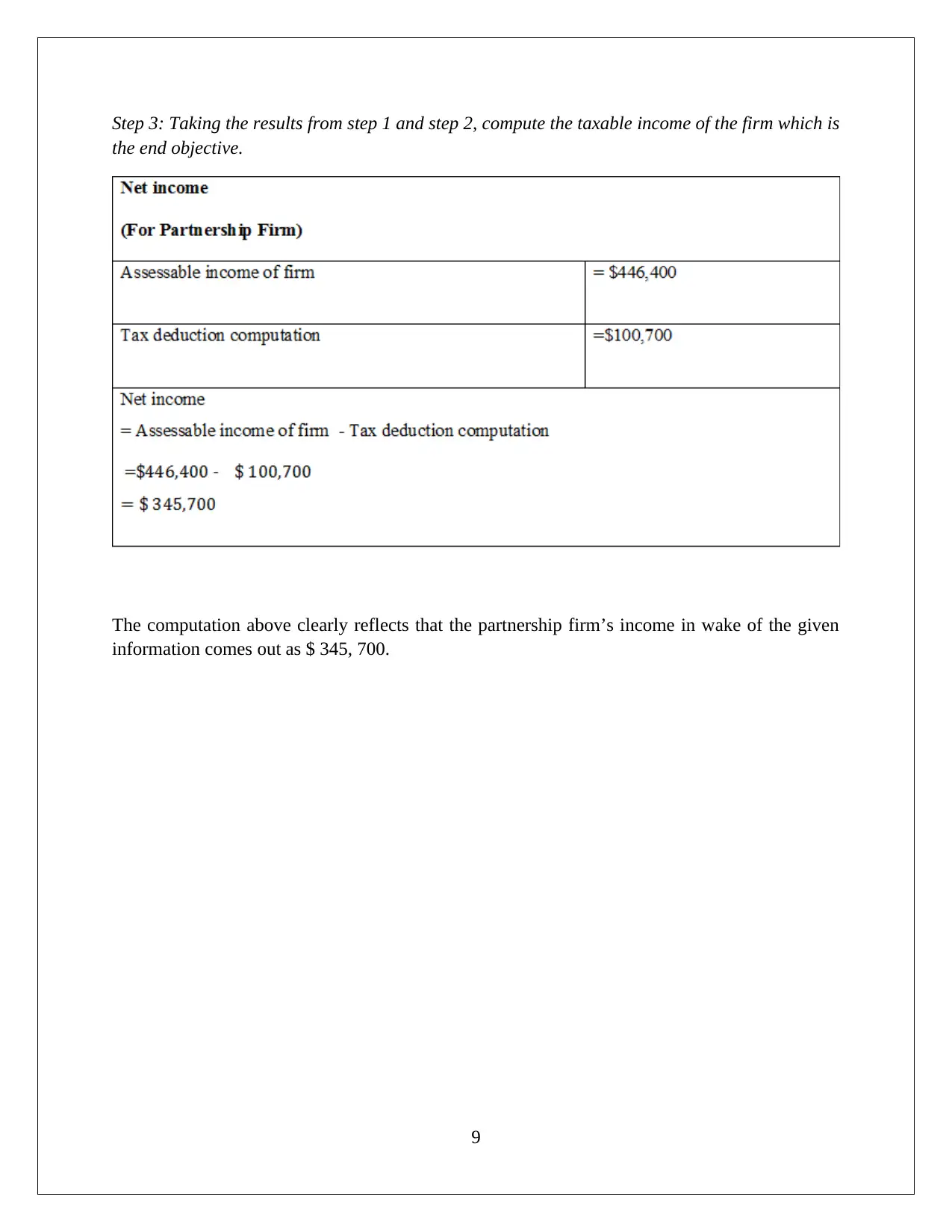
Step 3: Taking the results from step 1 and step 2, compute the taxable income of the firm which is
the end objective.
The computation above clearly reflects that the partnership firm’s income in wake of the given
information comes out as $ 345, 700.
9
the end objective.
The computation above clearly reflects that the partnership firm’s income in wake of the given
information comes out as $ 345, 700.
9
Paraphrase This Document
Need a fresh take? Get an instant paraphrase of this document with our AI Paraphraser
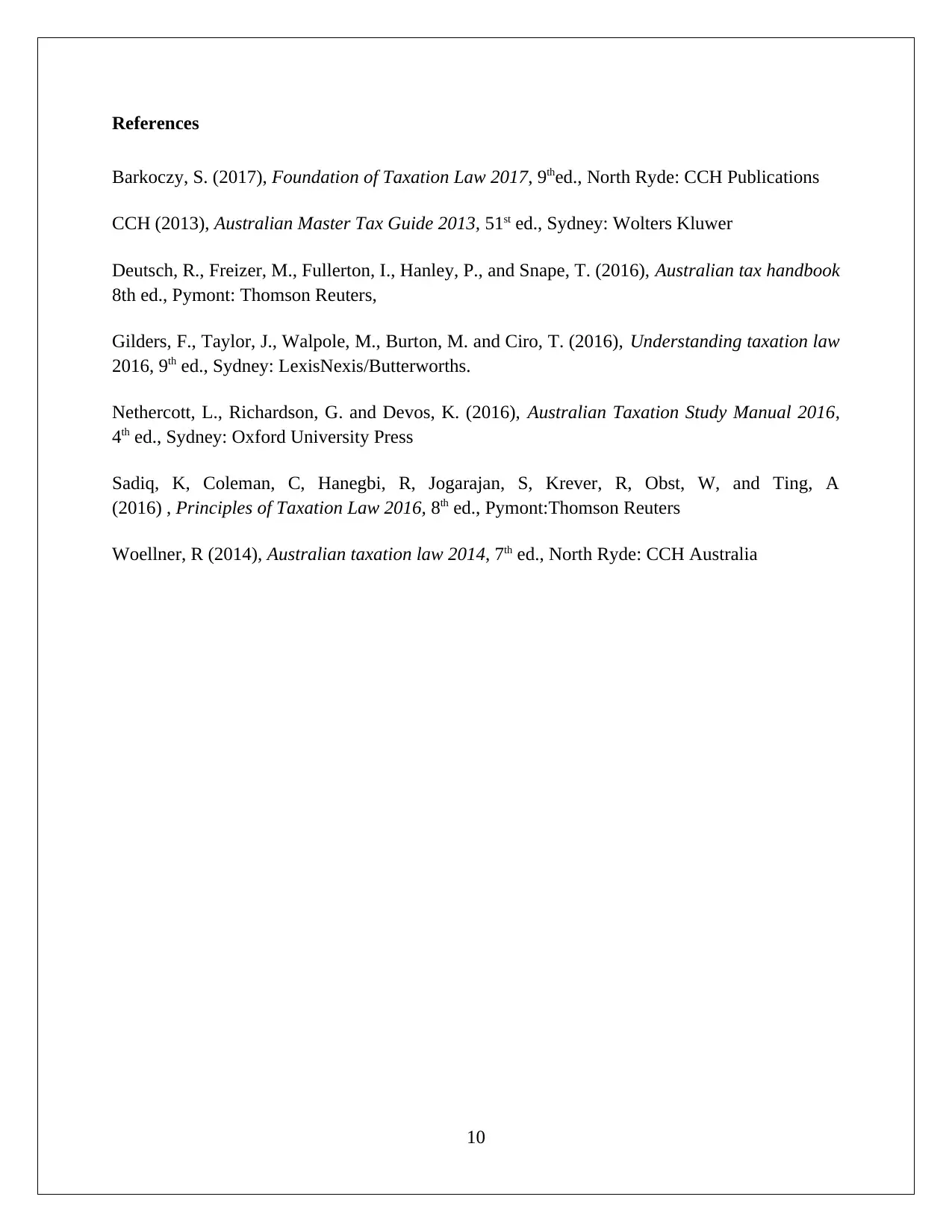
References
Barkoczy, S. (2017), Foundation of Taxation Law 2017, 9thed., North Ryde: CCH Publications
CCH (2013), Australian Master Tax Guide 2013, 51st ed., Sydney: Wolters Kluwer
Deutsch, R., Freizer, M., Fullerton, I., Hanley, P., and Snape, T. (2016), Australian tax handbook
8th ed., Pymont: Thomson Reuters,
Gilders, F., Taylor, J., Walpole, M., Burton, M. and Ciro, T. (2016), Understanding taxation law
2016, 9th ed., Sydney: LexisNexis/Butterworths.
Nethercott, L., Richardson, G. and Devos, K. (2016), Australian Taxation Study Manual 2016,
4th ed., Sydney: Oxford University Press
Sadiq, K, Coleman, C, Hanegbi, R, Jogarajan, S, Krever, R, Obst, W, and Ting, A
(2016) , Principles of Taxation Law 2016, 8th ed., Pymont:Thomson Reuters
Woellner, R (2014), Australian taxation law 2014, 7th ed., North Ryde: CCH Australia
10
Barkoczy, S. (2017), Foundation of Taxation Law 2017, 9thed., North Ryde: CCH Publications
CCH (2013), Australian Master Tax Guide 2013, 51st ed., Sydney: Wolters Kluwer
Deutsch, R., Freizer, M., Fullerton, I., Hanley, P., and Snape, T. (2016), Australian tax handbook
8th ed., Pymont: Thomson Reuters,
Gilders, F., Taylor, J., Walpole, M., Burton, M. and Ciro, T. (2016), Understanding taxation law
2016, 9th ed., Sydney: LexisNexis/Butterworths.
Nethercott, L., Richardson, G. and Devos, K. (2016), Australian Taxation Study Manual 2016,
4th ed., Sydney: Oxford University Press
Sadiq, K, Coleman, C, Hanegbi, R, Jogarajan, S, Krever, R, Obst, W, and Ting, A
(2016) , Principles of Taxation Law 2016, 8th ed., Pymont:Thomson Reuters
Woellner, R (2014), Australian taxation law 2014, 7th ed., North Ryde: CCH Australia
10
1 out of 11
Related Documents
Your All-in-One AI-Powered Toolkit for Academic Success.
+13062052269
info@desklib.com
Available 24*7 on WhatsApp / Email
![[object Object]](/_next/static/media/star-bottom.7253800d.svg)
Unlock your academic potential
Copyright © 2020–2025 A2Z Services. All Rights Reserved. Developed and managed by ZUCOL.





